
The Ultimate Guide to Exploring Tra Que Vegetable Village in Hoi An+ Videos
Vietnam is a country where farming is a way of life, making agriculture a common sight in every village you visit. Just on the outskirts of Hoi An’s Ancient Town lies the famous Tra Que Vegetable Village, renowned for its lush fields and vibrant produce. It’s a must-visit spot for nearly every traveler exploring Hoi An. In this article, we’ll dive into what makes this village so captivating and provide you with a complete guide on how to experience it for yourself.
What makes Tra Que special?
Experiences in Tra Que
Daily sights in Tra Que
Tra Que weather
Directions & transport
Entrance fee
Attractions near Tra Que
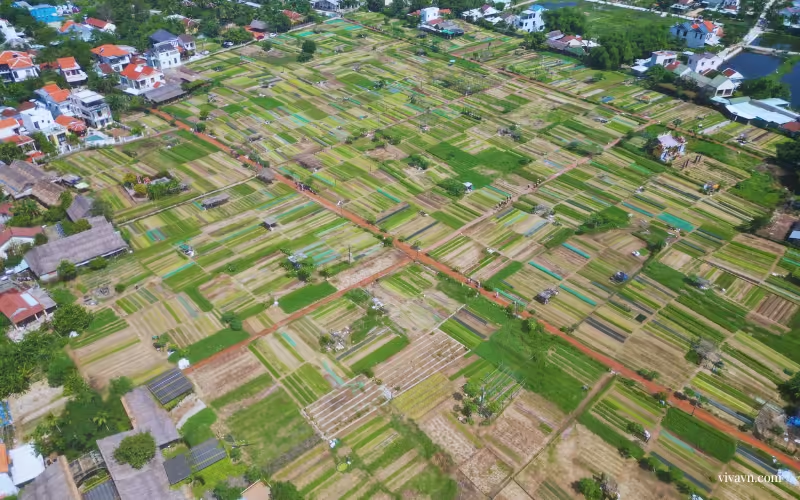
What makes Tra Que Vegetable Village so special?
Let’s take a deep dive into the fascinating history and unique flavors of the herbs and vegetables from Tra Que Village! We’ll uncover how the locals practice organic farming and why this charming village has captured the hearts of many.
A 400-year legacy of traditional vegetable farming
About 400 years ago, the first Vietnamese settlers arrived in this area, mostly working as farmers and fishermen. As they prepared meals, they discovered that shrimp and fish cooked with the local vegetables had a unique, delicious flavor. That’s when the villagers decided to start collecting seeds and growing these vegetables themselves, kicking off Tra Que Village’s long-standing tradition of vegetable farming.
At first, the villagers simply grew vegetables to feed their families. But as they got better at farming, they expanded their land and started selling vegetables to their neighbors. Thanks to their delicious, unique flavor, Tra Que vegetables became famous throughout the region. Today, the descendants of those early settlers still carry on the tradition of keeping vegetable farming alive in Tra Que village.
The vegetables and herbs here have unique flavors you won’t find anywhere else
Tra Que Village grows over 40 types of vegetables, fruits, and herbs! Some of the most popular varieties include green onions, cilantro, Vietnamese coriander, Thai basil, perilla, cilantro, and even delicious fruits like winter melon and papaya.
These plants are known for their small, thick leaves and compact stature, with many herbs boasting incredibly fragrant aromas. Locals in Hoi An often say that to truly enjoy their famous dishes like Mì Quảng and Cao Lầu, you can’t skip the fresh greens from Tra Que Vegetable Village. They believe that these locally grown vegetables elevate the flavors.
The legend goes that the taste of the herbs and vegetables from Tra Que Village captivated the Nguyen king, leading him to rename the village after two of its plants.
In the 18th century, King Gia Long of the Nguyen Dynasty made a stop at the village. The villagers offered him the freshest and most delicious vegetables they had grown. Upon tasting them, the king was particularly impressed by a type of vegetable with a fragrant aroma like camellia and a spicy flavor reminiscent of cinnamon. After returning to the capital, he issued a decree changing the name of the village to Tra Que, which means “camellia and cinnamon” in Vietnamese.
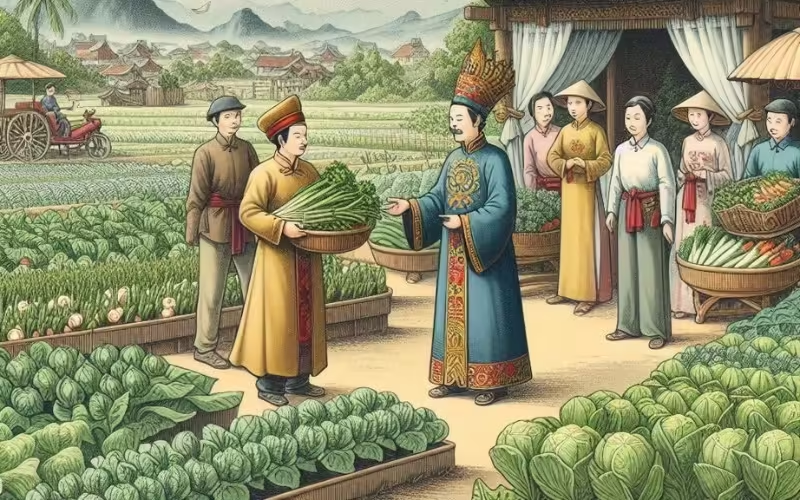
Farmers use organic methods to promote sustainability and protect the environment.
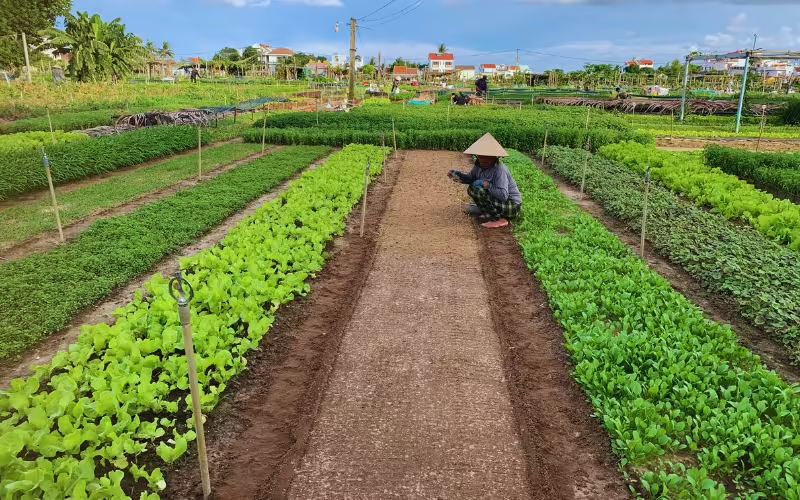
Farmers in Tra Que Vegetable Village grow their vegetables using traditional methods passed down through generations. When you visit, you’ll notice that their farming tools are quite simple and handmade. They cultivate native seeds that have thrived in this land for hundreds of years, perfectly suited to the local soil.
These farmers are very mindful of protecting their farmland, so they avoid using chemical fertilizers and pesticides. Instead, they use a unique fertilizer sourced from seaweed collected from a nearby lagoon. This seaweed is believed to contribute to the special flavor of the vegetables grown here.
What exciting experiences await you in Tra Que Vegetable Village?
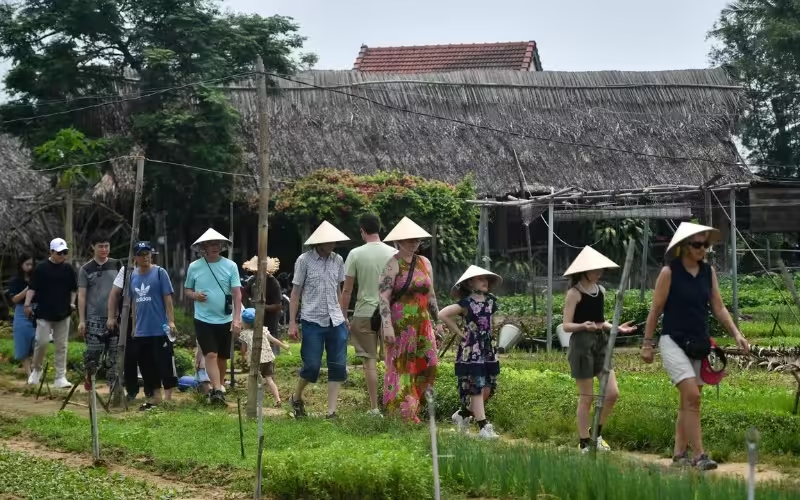
Over 20 years ago, Tra Que Vegetable Village opened its doors to tourists, inviting them to explore the art of vegetable farming in this beautiful area. Let’s dive into the authentic experiences this village offers when you visit!
Enjoy the peaceful paths of Tra Que
Stroll along the quaint paths of the village, taking in the peaceful scenery and lush vegetable gardens, while watching the hardworking farmers tend to their crops. This experience offers a glimpse into how the Vietnamese approach farming.
Here’s a fun fact: the paths in Tra Que Vegetable Village are named after the local herbs and vegetables! You can stroll down Basil Street or Malabar Spinach Road, making your walk an experience filled with the flavors of the village!
Planting, watering, and fertilizing the vegetables yourself
Not only can you observe, but you also get to roll up your sleeves and dive into the daily tasks of the local farmers. From tilling the soil and planting vegetables to watering the crops and adding fertilizer, these hands-on experiences give you a complete insight into how farming is done here.
Tip: The farmers here are incredibly friendly! Just ask, and they’ll happily guide you through the hands-on practices of farming.
Learn how to cook traditional Vietnamese dishes
In Tra Que Vegetable Village, you can join cooking classes where experienced chefs teach you how to make traditional Vietnamese dishes like Banh Xeo, Mi Quang, Nem Ran, Goi Cuon, and Tam Huu. Using fresh herbs and vegetables grown right here, it’s a fantastic way to learn how locals create these amazing flavors. Plus, you’ll get to taste the farm-fresh greens yourself, making it a truly authentic experience!
What to see at different times of day
Farmers in Tra Que Vegetable Village start their day early, often heading to their fields by 5 AM to harvest vegetables to sell at the local markets. They work until around 11 AM before heading home for a break. By 3 PM, they’re back in the fields, continuing their work until about 5 PM.
These are the best times to catch the farmers in action and experience the bustling atmosphere of daily life. If you’re visiting the village, it’s worth coming during these hours to see the locals at work. Between 11 AM and 3 PM, the village tends to be quieter and less active.
Tip: Sunrise and sunset are the best times to enjoy the peaceful scenery of Tra Que village. If possible, try to visit during these times to fully appreciate the tranquility and beauty of the surroundings.
The weather in Tra Que Vegetable Village
Hoi An enjoys a tropical monsoon climate, which means warm weather all year round, with average temperatures between 24 and 30 degrees Celsius. Let’s dive into the four distinct weather phases you can expect in both Hoi An and Tra Que.
 The first three months are cool, with gentle sunshine and occasional showers.
The first three months are cool, with gentle sunshine and occasional showers. From April to July, it’s the hottest time of the year, with temperatures reaching up to 36-37°C on some days.
From April to July, it’s the hottest time of the year, with temperatures reaching up to 36-37°C on some days. August and September bring a transition period, with light sunshine, afternoon rain showers, and pleasant, cooler evenings.
August and September bring a transition period, with light sunshine, afternoon rain showers, and pleasant, cooler evenings. While the last three months of the year are the rainy season, with occasional flooding in both Tra Que and nearby Hoi An, there are still many sunny days that are perfect for exploring the area.
While the last three months of the year are the rainy season, with occasional flooding in both Tra Que and nearby Hoi An, there are still many sunny days that are perfect for exploring the area.How to get to Tra Que Village from Hoi An Ancient Town
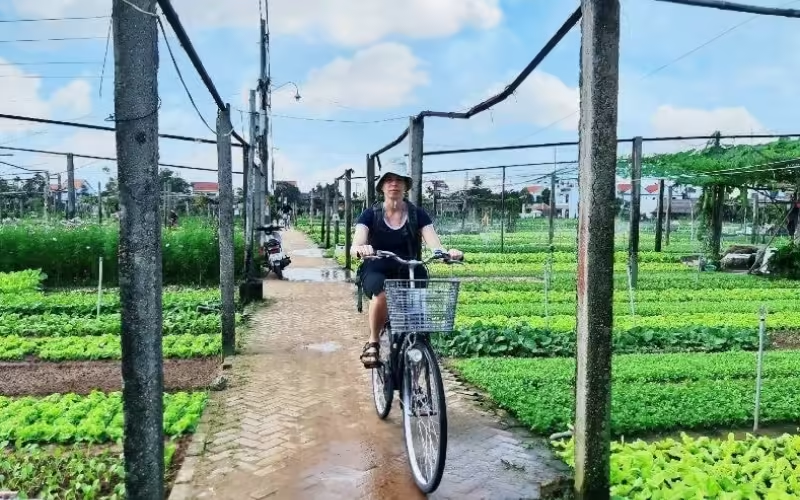
Directions
Tra Que Vegetable Village is located about 4 km northeast of Hoi An Ancient Town. After you pass through the old town, you’ll stroll by a beautiful rice field before reaching the village. This rice field is a delightful stop you won’t want to miss! You can take a moment to watch the farmers at work or admire the water buffalo grazing nearby. Some locals even offer buffalo riding services—just pay a small fee, hop on, and snap some great photos!
Note: Tra Que Vegetable Village is divided into two parts, separated by Hai Ba Trung Street. If you’re coming from Hoi An Ancient Town, you’ll most likely enter the right side of the street. Don’t worry—you can explore the other part when you leave the village, just across the street!
Transport
Getting from Hoi An Ancient Town to Tra Que Village is easy—you can choose to bike, ride a motorbike, take a taxi, use Grab, or even walk. But honestly, we recommend biking or walking for the best experience! You’ll find plenty of affordable bike rental shops in the old town.
Tip: Tra Que Herb Village is just about 1 km away from the beautiful An Bang Beach. After exploring the village, you can easily head towards the beach to enjoy the stunning coastal views!
Is there an entrance fee for Tra Que Village?
The entrance fee to visit Tra Que Vegetable Village is 35,000 VND per person (around $1.50 USD) in 2024. After buying your ticket, you’ll get a free drink made with lemon basil seeds at a nearby restaurant. The seeds are harvested right from the gardens here.
With this ticket, you can explore Tra Que Village. If you’d like to join a cooking class, you’ll need to contact one of the restaurants in the village and pay an additional fee for the class.
Awesome attractions near Tra Que Vegetable Village
An Bang Beach
Just over 1 km from Tra Que Vegetable Village lies An Bang Beach, a pristine beach with a peaceful vibe. With soft, white sand, gentle waves, and crystal-clear waters, it’s perfect for swimming and sunbathing. Plus, you’ll find plenty of nearby seafood restaurants serving fresh dishes!
Cua Dai Beach
Not too long ago, Cua Dai Beach was a breathtaking paradise, but due to significant erosion, its size has shrunk and the landscape has changed. That said, if you visit today, you’ll still find its natural beauty intact, with a long stretch of soft white sand and palm trees lining the shore.
Cam Thanh Coconut Village
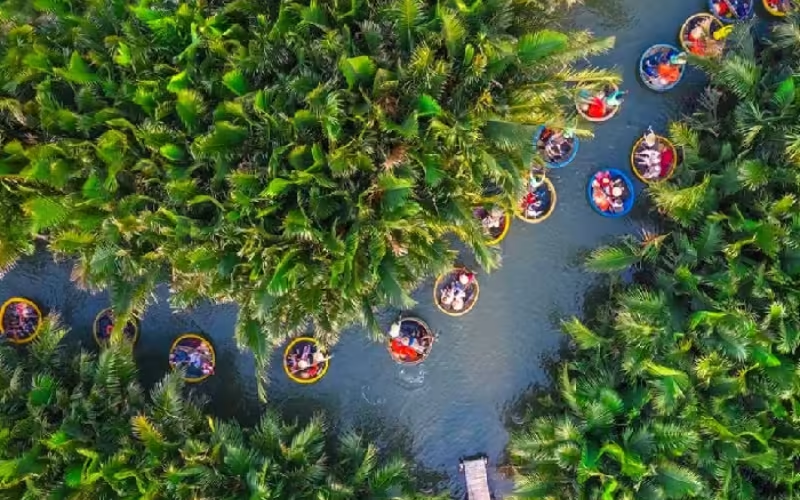
Cam Thanh Coconut Forest, also known as Bay Mau Coconut Forest, is one of the unique Hoi An Villages. Just 8 km from Tra Que Vegetable Village, this area boasts a fascinating ecosystem of water coconut palms. When you visit, you can enjoy a basketboat ride on the river and take in the untouched natural beauty around you.
Share on FacebookShare on X (Twitter)Share on PinterestShare on WhatsappShare on LinkedinShare on TelegramShare on Email
- https://www.youtube.com/@VivaVNOfficial
- https://www.facebook.com/vivavnofficial2024
- https://www.pinterest.com/vivavnofficial/
© 2025 VivaVN. All rights reserved.

Leave a Reply